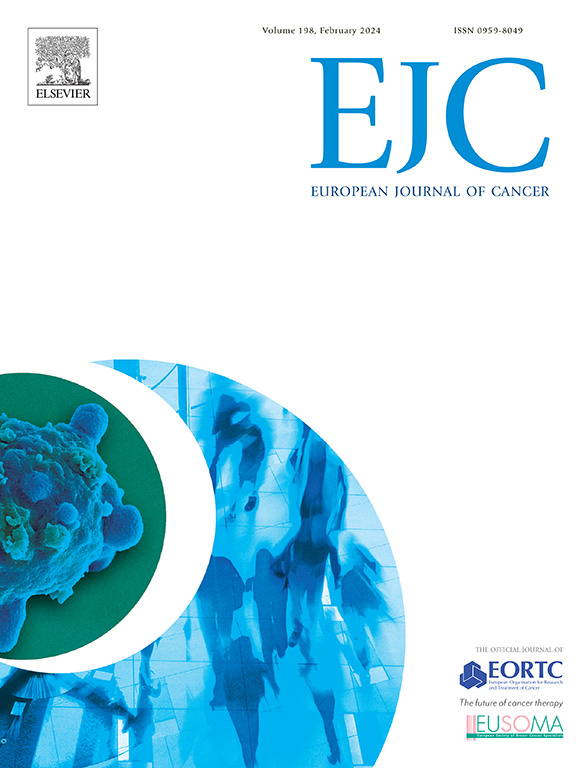Exploring isolated tumor cells entity in endometrial cancer
IF 7.6
1区 医学
Q1 ONCOLOGY
引用次数: 0
Abstract
Background
Endometrial cancer (EC) management includes nodal staging and molecular classification. Despite molecular advancements, the biological significance of isolated tumor cells (ITC) in EC remains unclear. This study aimed to characterize ITC in the context of pathological and molecular features
Materials and methods
A multicenter, retrospective analysis included EC patients diagnosed between June 2018 and May 2024 who underwent surgical staging via sentinel lymph node (SLN) biopsy and molecular profiling. ITC cases detected through SLN ultrastaging or One Step Nucleic Acid Amplification (OSNA) were compared with N0 and N + (micro-/macrometastasis) groups.
Results
Among the 1821 patients included, nodal status was N0 in 84.5 %, ITC in 5.1 %, micrometastases in 5.3 %, and macrometastases in 4.5 %. ITC patients exhibited deep myometrial invasion in 67.7 % of cases vs. 28.7 % in N0 (p < 0.001). Diffuse lymphovascular space invasion (LVSI) was significantly higher in ITC (52.1 %) than N0 (12.2 %, p < 0.001). MMR deficiency was more frequent in ITC (33.3 %) vs. N0 (25.0 %, p = 0.07). POLE mutations were more common in N0 (4.2 %) and ITC (3.1 %) vs. N + (1.1 %), though not statistically significant. p53-abnormal tumors were significantly associated with N + status (19.4 %) compared to ITC (7.3 %, OR 0.33, p = 0.008). No relapses occurred among ITC patients with low-risk features.
Conclusions
These findings suggest that ITC may represent an early form of nodal involvement, biologically distinct from micro- and macrometastases. The association with MMR deficiency and the absence of aggressive markers such as p53 abnormalities support a less aggressive profile. Integrating molecular and pathological features may refine risk stratification and inform management strategies for EC patients with ITC.
探讨子宫内膜癌中分离的肿瘤细胞实体
背景子宫内膜癌(EC)的治疗包括淋巴结分期和分子分类。尽管分子方面取得了进展,但分离肿瘤细胞(ITC)在EC中的生物学意义尚不清楚。本研究旨在在病理和分子特征的背景下表征ITC。材料和方法多中心回顾性分析包括2018年6月至2024年5月诊断的EC患者,这些患者通过前哨淋巴结(SLN)活检和分子分析进行了手术分期。通过SLN超移或一步核酸扩增(One - Step Nucleic Acid Amplification, OSNA)检测到的ITC病例与N0和N + (微/大转移)组进行比较。结果本组1821例患者中,84.5% %为无淋巴结,5.1% %为ITC, 5.3% %为微转移,4.5% %为大转移。ITC患者出现深部肌层侵犯的比例为67.7% %,而N0患者为28.7% % (p <; 0.001)。ITC组弥漫性淋巴血管间隙侵犯(LVSI)发生率(52.1 %)明显高于对照组(12.2 %,p <; 0.001)。MMR缺乏症在ITC组(33.3% %)比N0组(25.0% %,p = 0.07)更为常见。与N + (1.1 %)相比,N0(4.2 %)和ITC(3.1 %)的POLE突变更为常见,但无统计学意义。与ITC(7.3 %,OR 0.33, p = 0.008)相比,p53-异常肿瘤与N + 状态显著相关(19.4 %)。具有低危特征的ITC患者无复发。这些发现表明,ITC可能代表了淋巴结累及的一种早期形式,在生物学上不同于微转移和大转移。与MMR缺乏和缺乏侵袭性标志物(如p53异常)的关联支持了侵袭性较低的特征。整合分子和病理特征可以细化风险分层,并为EC合并ITC患者提供管理策略。
本文章由计算机程序翻译,如有差异,请以英文原文为准。
求助全文
约1分钟内获得全文
求助全文
来源期刊

European Journal of Cancer
医学-肿瘤学
CiteScore
11.50
自引率
4.80%
发文量
953
审稿时长
23 days
期刊介绍:
The European Journal of Cancer (EJC) serves as a comprehensive platform integrating preclinical, digital, translational, and clinical research across the spectrum of cancer. From epidemiology, carcinogenesis, and biology to groundbreaking innovations in cancer treatment and patient care, the journal covers a wide array of topics. We publish original research, reviews, previews, editorial comments, and correspondence, fostering dialogue and advancement in the fight against cancer. Join us in our mission to drive progress and improve outcomes in cancer research and patient care.
 求助内容:
求助内容: 应助结果提醒方式:
应助结果提醒方式:


